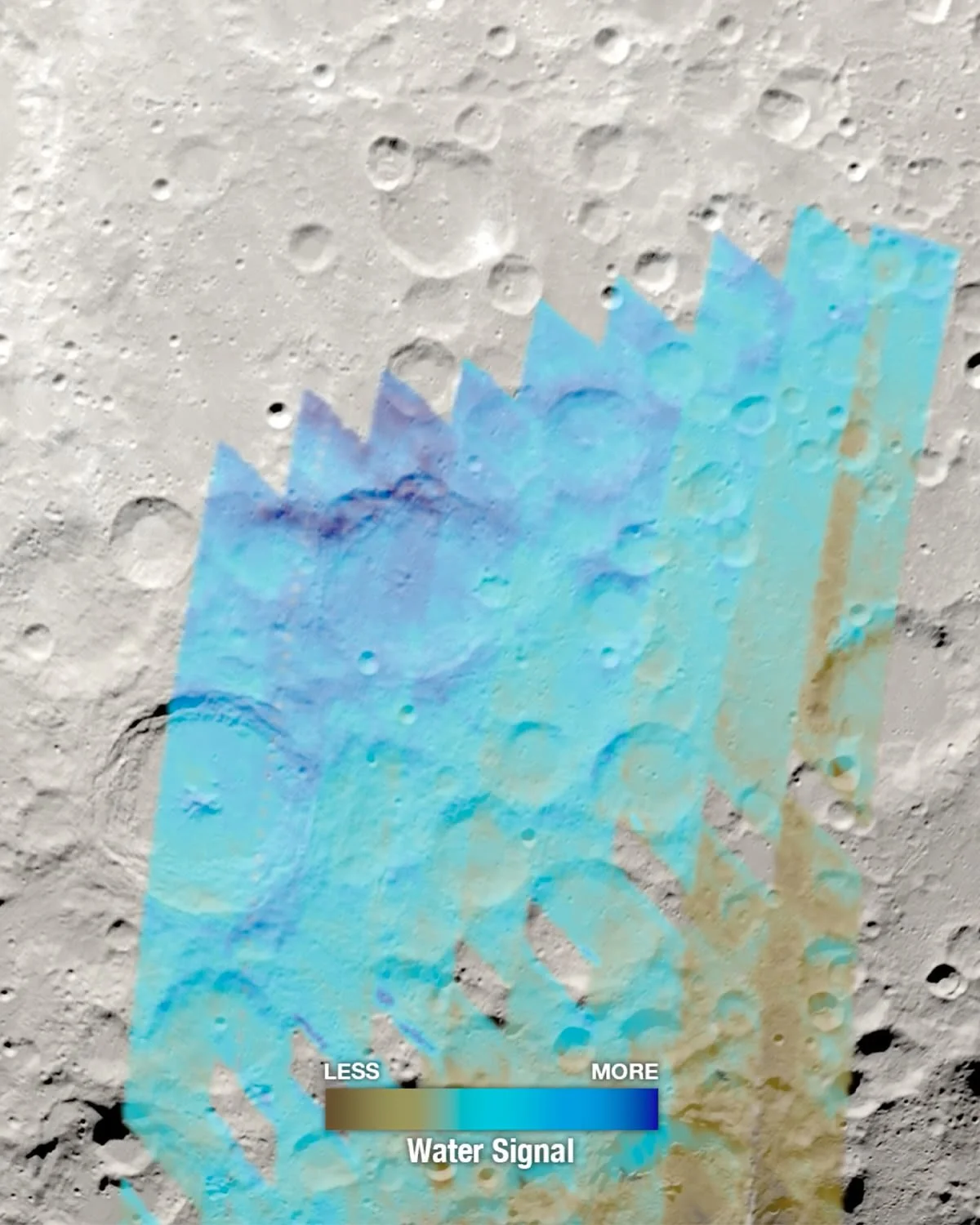THE CASE FOR MINING RESOURCES IN SPACE
Lunar and asteroid mining offer practical pathways for fueling a burgeoning New Space industry. Transporting resources from Earth to space for space-based activities is currently neither cost-effective nor sustainable while returning space-based resources to Earth makes little economic or technical sense. However, a long-term perspective on space mining would benefit Earth: there are vast resources in space, and Earth has an increasing demand for critical metals which are crucial for transitioning to a decarbonized economy.
Today, demand for strategic minerals outpaces supply as humanity plunges deeper into a human-made climate crisis. We urgently need new sources of critical metals that we can access without leaving scars of environmental degradation on our planet. Lunar and asteroid mining offer new targets for resource extraction and responsible resource stewardship.
It’s possible to design an in-space economy with forward-looking aspirations of providing metals for Earth's energy and industrial transition. By first prioritizing in-space water utilization for space-based industrial activities, the roadmap for space resource utilization could eventually encompass both water and metal extraction for in-space purposes and the provision of space-based metals for terrestrial needs.
Today’s space-faring nations have focused on lunar ice as a first step in long-term space-resource utilization. Water is an enabler of the space industry. This year’s lunar missions and research by the U.S., China, India, and Russia have been characterized by the pursuit of this life-sustaining resource. Water on the moon is critical for human consumption and radiation shielding, and hydrogen and oxygen produced via electrolysis can be used for life support or combusted for rocket propulsion, as detailed in Kornuta et. al’s “Commercial Lunar Propellant Architecture: A Collaborative Study of Lunar Propellant.”
As the space industry grows, technology advances and costs drop, metals for use-in-space manufacturing and metals for return-to-Earth scenarios will become possible for humanity’s technology and resource roadmaps. Enabling and incentivizing water-for-use-in-space foundational activities can help materialize in-space manufacturing and resourcing.
In the context of space resource economics, John Lewis' 1998 book "Mining the Sky" highlights three key points: First, it emphasizes the significant cost of transporting materials from Earth to space, meaning industrial activities occurring in space should be made with materials from space. Second, Lewis suggests that only materials with a high market value on Earth would justify the cost of transporting them back from space. Third, it underscores that the energy cost of sending materials back to Earth from near-Earth space is likely to be lower than the cost of launching from Earth, making Earth more suitable as an importer rather than an exporter of raw materials due to its deep gravity well.
Unless the cost of raw materials on Earth substantially increases, space resources are best used in space rather than brought to Earth. For example, cobalt’s ten-year average price of $33,420/metric ton is far from the “thousands of dollars per kilogram” requirement to make return-to-Earth metals extraction economically feasible. Platinum, however, has a ten-year average price of $891.82/troy ounce ($28,672,013/metric ton) with a forecast of demand pickup and lower supply.
The particulars of each metal will heavily impact the economic viability of a return-to-Earth scenario within the unit economics of a lunar or asteroid mining operation. Future research considerations in this arena are the impact of major pricing changes on global trade, including the global deployment of a carbon tax (or other financial schemes to incorporate externalities as costs within operating expenses) and geopolitical bottlenecks that disrupt prices and increase volatility. These changes may tip the balance from terrestrial materials sourcing (deep-sea mining and metals recycling) to space-based return-to-Earth via lunar or asteroid mining.
To foster an in-space economy, we should turn to celestial bodies as resource hubs.
The move away from fossil fuel-based inputs for industrial activities has sparked demand for critical minerals to power decarbonized industrial, commercial, and residential activities. A 2022 IEA reportnotes that solar plants, wind farms, and electric vehicles (EVs) “require more minerals to build than their fossil fuel-based counterparts. A typical electric car requires six times the mineral inputs of a conventional car and an onshore wind plant requires nine times more mineral resources than a gas-fired plant. Since 2010 the average amount of minerals needed for a new unit of power generation capacity has increased by 50% as the share of renewables in new investment has risen.” Amidst this context, demand for critical minerals has skyrocketed.
Increased metals demand for a transition to a less carbon-dependent industry has strained supply chains, making more consequential the geopolitical relationships of minerals-rich countries, while further incentivizing extractive activities. Expanding global resource extraction deepens human and labor rights crises and environmental degradation and each critical metal embodies its own geopolitical, labor, and environmental impact. For example, lithium carbonate, a key input for battery metals, traded from South America to Asia, the U.S., and Europe is linked to soil degradation and groundwater contamination, while cobalt, used in batteries and high-strength alloys, largely originates from the Democratic Republic of the Congo where child labor is commonplace within the industry.
Economists at the IMF estimated that “replacing fossil fuels with low-carbon technologies would require an eightfold increase in renewable energy investments and cause a strong increase in demand for metals. However, developing mines is a process that takes a very long time—often a decade or more—and presents various challenges, at both the company and country level. Given the projected increase in metals consumption through 2050 under a net zero scenario, current production rates of graphite, cobalt, vanadium, and nickel appear inadequate. Current copper, lithium, and platinum supplies also are inadequate to satisfy future needs.”
Two solutions to critical metals demand dominate current policy discussions and investment trends: deep-sea mining and metals recycling. The third and fourth options, lunar mining and asteroid mining are considered here as long-term solutions for heavy industrial activity off-Earth that may grow in attractiveness as space technology evolves. Demonstrated technological feasibility will encourage interest and investment in solutions previously thought to be impossible for use-in-space and return-to-Earth resource scenarios; having a long-term roadmap encompassing both will advance the space industry while ensuring terrestrial challenges are prioritized.
Dependency on Fossil Fuel
Lunar and asteroid mining hold promise as future solutions to the growing demand for critical minerals. As space technology advances, these methods may become more economically and technically viable. In-space mining not only has the potential to address Earth's need for critical metals but also paves the way for expanding human activities and industries beyond our planet, thereby enhancing our scientific and exploratory capabilities within and beyond our solar system.
The early space economy, as detailed in Kornuta et. al's Commercial Lunar Propellant Architecture, must leverage In-Situ Resource Utilization (ISRU) to enable “the efficient use of resources both on Earth and in space, as well as continued expansion and development of human presence outside of our planet.”
Water extracted from lunar regolith converted into rocket propellant would enable new missions further into our solar system or beyond, advancing industrial development and expanding scientific exploration. Additional lunar resources of strategic importance include Helium-3, used for nuclear fusion for power generation, as well as rare earths. While lunar ice prospecting continues, the 2023 SOFIA Map of Water Near the Moon's South Pole “assembled the first detailed, wide-area map of water distribution on the Moon, shown below.”
Lunar and Asteroid Mining
The SOFIA observation, visualized as it appeared on February 17, 2022, is “shown in shades of blue (stronger water signal) and brown. The visualization includes a color key and latitude-longitude grid near the South Pole. This is a vertical aspect ratio version.”
This confirmation of ice on the lunar South Pole further emboldens multiple nations’ plans to establish a permanent presence on the moon. The 2024 NASA Volatiles Investigating Polar Exploration Rover (VIPER) mission will land in this region “to conduct the first resource mapping mission beyond Earth.” With prospecting missions still underway and lunar industrialization years out, lunar-extracted resources in the near future should be considered cost-prohibitive for return-to-Earth applications. Lunar resources, at this time, can only be considered for use-in-space applications.
Asteroid mining for a return-to-Earth scenario, like lunar mining, is only feasible if the cost of asteroid-based extraction drops below the cost of Earth-based extraction, but the financial upside may be worth the risk for investors with deep pockets and tolerance for a decades-long return on investment (ROI). Private company Karman+ aims to launch its first asteroid mining mission in 2026 with an explicit corporate mission to “mine space resources from near-Earth asteroids to provide abundant, sustainable energy and resources in space and for Earth.” Asteroid water can be used for in-space propellant, and iron and nickel could be used to replace depleted Earth resources or for industrial activities in space.
As described by NASA, in reference to John S. Lewis’ Mining the Sky, “The comets and asteroids that are potentially the most hazardous because they can closely approach the Earth are also the objects that could be most easily exploited for their raw materials.” Validating this, the Near-Earth Object (NEO), Bennu, whose sample was returned to Earth in September, has evidence of carbon and water.
The NASA explainer continues, “It is not presently cost-effective to mine these minerals and then bring them back to Earth. However, these raw materials could be used in developing space structures and in generating the rocket fuel that will be required to explore and colonize our solar system in the twenty-first century. Whereas asteroids are rich in the mineral raw materials required to build structures in space, the comets are rich resources for the water and carbon-based molecules necessary to sustain life.
In addition, an abundant supply of cometary water ice could provide copious quantities of liquid hydrogen and oxygen, the two primary ingredients in rocket fuel. It seems likely that in the next century when we begin to settle the inner solar system, the metals and minerals found on asteroids will provide the raw materials for space structures, and comets will become the watering holes and gas stations for interplanetary spacecraft.”
As a space-based commercial economy develops, nations that lock in space manufacturing and infrastructure will benefit from a first-mover advantage. As the National Space Council Users’ Advisory Groupnotes, “While the development of the industrial capability to access and make use metals and other materials “in situ” (on-site) will take longer, designing and securing the infrastructure that supports it is a task that should not continue to be postponed: The nation that first profitably develops these resources will secure a position of global economic and geopolitical leadership for generations to come.” This explains today’s American, Chinese, Russian, and Indian ambitions to land, prospect, and industrialize the lunar surface.
Certain early infrastructure plays will be more advantageous, ensuring long-term resource security, as the U.S. government has suggested with its assessment of a strategic in-space propellant reserve. By developing an industrial setting from which rockets could fuel in space, countries and companies can reduce costs associated with launching to escape Earth’s gravity well. As 80% of a rocket’s mass is propellant, any reduction in propellant requirement improves overall project cost. While today’s Earth-based launch costs to Low-Earth Orbit (LEO) have dropped from $65,000/kg to $1,500/kg, in-space propellant availability will further enable economic activity, space industrialization, and exploration.
Water from the Moon or asteroids converted to propellant in space will enable this first industrial activity; of course, getting to the Moon remains significantly challenging, with almost half of Moon landings ending in failure.
Development of a U.S. Space Propellant Reserve would enable three key outcomes, according to the National Space Council Users’ Advisory Group:
“First, it would stimulate economic development by reducing uncertainty regarding the availability of propellant, enhancing confidence for governments and private interests alike. Secondly, it would buffer U.S. future in-space economic interests from temporary interruptions in supply. Finally, a reserve would also provide a significant means to help stabilize a future space commodities exchange, in which forward purchases (futures) of commodities such as water, oxygen, hydrogen, metals, and propellant, could be traded. All of these commodities are driven by transportation; therefore, investing up front in a strategic reserve can enable greater predictability in accessing, delivering, and utilizing them, creating some assurance and greater security in commercial activity.”
By contributing to a strategic reserve first for water/propellant and then for critical metals, companies, and countries can enjoy less volatility in a space-based supply chain for a burgeoning in-space economy. Should space resources be needed to address Earth’s supply, a propellant or metals reserve would ensure supply regardless of terrestrial geopolitical or environmental constraints.
The long-term vision of asteroid mining should include metals procurement for use-in-space and metals return, to support human development terrestrially and aid resource requirements on Earth amidst diminishing environmental conditions. While lunar- and asteroid-based resources can’t be considered near-term solutions to humanity’s dire critical minerals demand, advancing technologies that enable this potential future deserve further research and investment as we consider all solutions for advancements in human development, both on this planet and off.
DeLaine Mayer is a professor of astropolitics at New York University and has an MS in Global Affairs from NYU and an MS in Space Resources from Colorado School of Mines.
KEYWORDS: ASTEROID MINING, SPACE MINING, IN-SITU RESOURCE EXTRACTION, NASA, CLIMATE CHANGE, IN-SPACE ECONOMY




